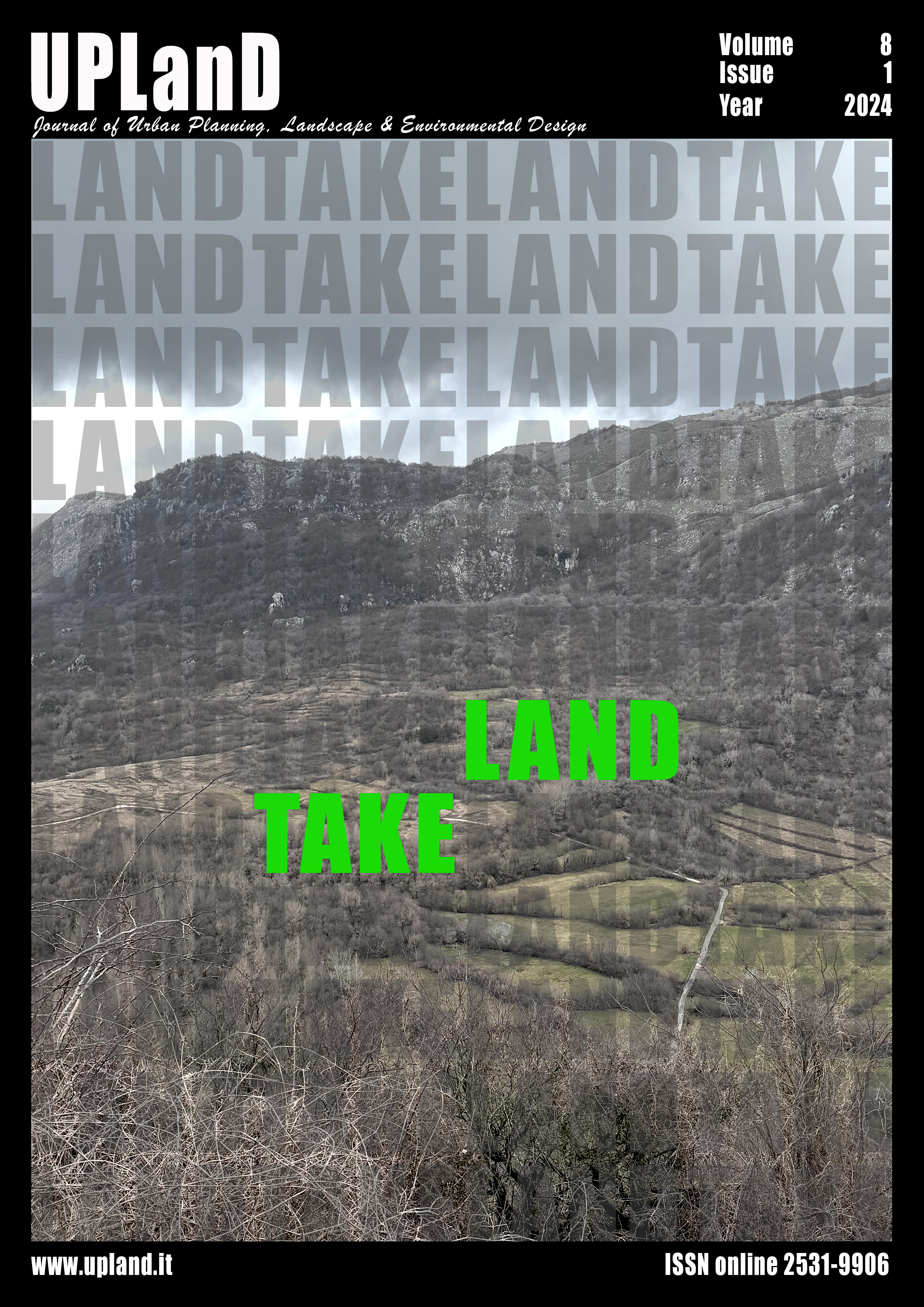Biodiversity Lab for the Urban Ecological Network in the Mediterranean Area. A shared commitment protocol for the city's natural capital
Main Article Content
Abstract
Green areas represent crucial elements for urban environments that promote the health and well-being of the community and the entire urban organism. An ecological approach to planning allows us to recognize the well-being of communities and urban systems as essential elements for effective planning to meet contemporary environmental and social needs. This contribution presents the results of extensive research that converge into a comprehensive laboratory work; an experimental field aimed at strengthening the transition process towards green and sustainable cities, focusing on the enhancement and implementation of natural capital within the vast territory of the metropolitan city of Reggio Calabria and its Aspromonte National Park. A multidisciplinary and experimental approach in collaboration between the University and the Metropolitan City of Reggio has led to the development of a theoretical and methodological framework consisting of a related system of principles, criteria, and essential measures to facilitate the initiation of early activities in support of the institutional entities of the Reggio metropolitan area. These entities are committed to managing the funds of the National Recovery and Resilience Plan - PNRR, and their missions fully align within the same experimentation field for the valorization of the ecological structure of urban and territorial greenery in the entire area and the networking of spaces for social interaction, thus ensuring a valued healthy climate urban profile
Downloads
Article Details

This work is licensed under a Creative Commons Attribution-NonCommercial-NoDerivatives 4.0 International License.
Authors who publish with this journal agree to the following terms:- Authors retain copyright and grant the journal right of first publication with the work simultaneously licensed under a Creative Commons Attribution License that allows others to share the work with an acknowledgement of the work's authorship and initial publication in this journal.
- Authors are able to enter into separate, additional contractual arrangements for the non-exclusive distribution of the journal's published version of the work (e.g., post it to an institutional repository or publish it in a book), with an acknowledgement of its initial publication in this journal.
- Authors are permitted and encouraged to post their work online (e.g., in institutional repositories or on their website) prior to and during the submission process, as it can lead to productive exchanges, as well as earlier and greater citation of published work (See The Effect of Open Access).
References
Bolund, P., Hunhammar, S., (1999). Ecosystem services in urban areas. Ecological Economics 29, 293-301.
Chiusura, A. (2009). Gestione ecosistemica delle aree verdi urbane: analisi e proposte. Istituto Superiore per la protezione e la ricerca ambientale. https://www.isprambiente.gov.it/contentfiles/00004100/4138-rapportoaree-verdi.pdf/
De Jong, M. A. J. G., Wagemakers, A., & Koelen, M. A. (2020). “We Don’t Assume That Everyone Has the Same Idea About Health, Do We?” Explorative Study of Citizens’ Perceptions of Health and Participation to Improve Their Health in a Low Socioeconomic City District. International Journal of Environmental Research and Public Health, 17(14), 4958.
Errigo, A. (2019). Fostering neighbourhood advantage for health implications and guidelines for urban regeneration. Università degli studi Mediterranea di Reggio Calabria.
Fallanca, C. & Stagno E. (2022). La rete ecologica urbana, un protocollo di impegno per il capitale naturalistico della città. In F. D. Moccia & M. Sepe (A cura di), XIII Giornata internazionale di studi Inu Oltre il futuro: emergenze, rischi, sfide, transizioni, opportunità (pp 405-407). Urbanistica Informazioni, 306.
Fallanca, C. & Stagno E. (2022). Toward the Development of a Planning Protocol for Public Space for Improving Health and Wellbeing of Communities. In F. Calabrò, L. Della Spina, M. J. Piñeira Mantiñán. New Metropolitan Perspectives: PostCOVID Dynamics: Green and Digital Transition, between Metropolitan and Return to Villages Perspectives (pp 549-558). Springer.
Fallanca, C. & Taccone, A. (2021). Designing a New Vision of an “Ordered” Nature with an Ecosystemic Approach for a Healthy City. In D. La Rosa & R. Privitera (A cura di) Innovation in Urban and Regional Planning 146 (pp 73–80). Springer International Publishing.
Fallanca, C. (2021). La Città Metropolitana, regia dei valori patrimoniali del territorio vasto di riferimento. In C. Fallanca (A cura di) CITTÀ METROPOLITANE. Linee progettuali per nuove relazioni territoriali (pp 9-21). Milano: FrancoAngeli
Fallanca, C. (2021). Per nuovi modelli di pianificazione del verde urbano della città di Reggio Calabria. Urbanistica Informazioni, 298-299, 40-44.
Fallanca, C. (2020). Places in the city designed for pro well-being living space. UPLanD-Journal of Urban Planning, Landscape & environmental Design, 5(2), 149-172.
Fallanca, C. (2022). Il linguaggio degli alberi. Tre considerazioni. In F. D. Moccia & M. Sepe (A cura di), XIII Giornata internazionale di studi Inu Oltre il futuro: emergenze, rischi, sfide, transizioni, opportunità (pp 382-384). Urbanistica Informazioni n. 306.
Higueras, E., Román, E., & Fariña, J. (2021). Guidelines for Healthier Public Spaces for the Elderly Population: Recommendations in the Spanish Context. In Handbook of Quality of Life and Sustainability (pp. 35-51). Springer, Cham
Iungman, T., et al., (2023). Cooling cities through urban green infrastructure: a health impact assessment of European cities.The Lancet, 401, 577 – 589.
Kaplan, R. e Austin, M. E., 2004. Out in the country: Sprawl and the quest for nature nearby. Landscape and Urban Planning, 69(2-3), 235-243.
Kaplan, R. S. Kaplan, (1989.) The experience of nature: A psychological perspective. New York: Cambridge University Press.
Leclercq, Els & Pojani, Dorina. (2020). Private, hybrid, and public spaces: Urban design assessment, comparisons, and recommendations.
Mirabile, M., (2004). Il verde urbano e la biodiversità nelle città. In: I Rapporto APAT “Qualità dell’ambiente urbano”
Stagno, E. (2022). LA SALUTE DELLE COMUNITA’ ATTRAVERSO LA PROGETTAZIONE DEGLI SPAZI PUBBLICI DI QUARTIERE – Sviluppo di un protocollo di pianificazione per la rigenerazione urbana per la salute. Università degli studi Mediterranea di Reggio Calabria
Tyrvainen, L., Paulei, S., Seeland, K., De Vries, S., (2005). Benefits and Uses of urban forests and trees. In. Konendijk, C., Nilsson, K., Randrup, T., Schipperijn, J. (Eds), Urban forests and trees in Europe: A Reference Book (pp: 81-114). Springer Verlag.

